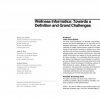CHI
2010
ACM
13 years 10 months ago
2010
ACM
CHI
2010
ACM
13 years 10 months ago
2010
ACM
Hierarchical structures with large fan-outs are hard to browse and understand. In the conventional node-link tree visualization, the screen quickly becomes overcrowded as users op...
CHI
2010
ACM
13 years 10 months ago
2010
ACM
This study explores language's fragmenting effect on usergenerated content by examining the diversity of knowledge representations across 25 different Wikipedia language edit...
CHI
2010
ACM
13 years 10 months ago
2010
ACM
Mobile services can provide users with information relevant to their current circumstances. Distant services in turn can acquire local information from people in an area of intere...
CHI
2010
ACM
13 years 10 months ago
2010
ACM
Protractor is a novel gesture recognizer that can be easily implemented and quickly customized for different users. Protractor uses a nearest neighbor approach, which recognizes a...
CHI
2010
ACM
13 years 10 months ago
2010
ACM
In the field of Human-Computer Interaction, provenance refers to the history and genealogy of a document or file. Provenance helps us to understand the evolution and relationships...
CHI
2010
ACM
13 years 10 months ago
2010
ACM
To accommodate frequent emergencies, interruptions, and delays, hospital staff continually make and coordinate changes to the surgery schedule. The technical and social aspects of...
ACMIDC
2010
13 years 10 months ago
2010
Children with autism often experience substantial challenges in understanding, structuring, and predicting the activities in their daily lives. The use of symbols to represent a s...
ACMDIS
2010
ACM
13 years 10 months ago
2010
ACM
In this paper, we examine the ideas behind and reactions to a prototype online tool designed, in-house, for an art college's interaction design department. The web-based prot...
ACMDIS
2010
ACM
13 years 10 months ago
2010
ACM
Infrastructure awareness systems reveal invisible aspects of infrastructures to their existing or potential users. Designing such systems is challenging as it requires making visi...






